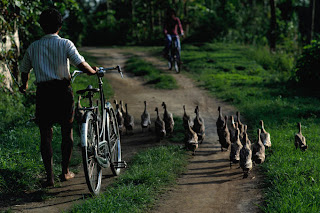Artistically, Bali is a mixture of cultures and traditions. The Balinese people have a natural capacity for absorbing different cultural elements and blending them with their own. For centuries, artists and craftsmen in Bali worked under the benefaction of priests and ruling classes,decorating palaces and temples. The artists never signed their work and usually lived closely together in special villages.
As their designs followed strict aesthetic and religious guidelines,the artists generally didn't have much room for personal expression. With the arrival of european artists in the beginning of the 20th century, this soon began to change. Local artists started to develop their own individual styles.
PAINTING
Until the start of the 20th century, the dominant form of painting was the portrayal of Hindu epics by painters and illustrators called 'sangging'. Aside from making large representational paintings, the sangging were expected to decorate everything from gourds, wooden altars, bamboo vessels, headboards for princely bed chambers and, and in particular,they were expected to ilustrate astrological wall hangings on bark paper or cloth. it wasn't until the early 1900s that western influences reached Bali. The use of Asian symbols in the works of, among others, Paul Gauguin, Toulouse Lautrec and Camille pissaro,created a new trend for Asian-influenced art and for european painters to move to Bali. Ubud's fame regarding art can be traced to the arrival of the German painter Walter Spies and the Dutch Rudolf Bonnet. There is a much wider range of artistic styles today.
Ubud Style
Influenced by the western use of perspective and everyday-life subject matter, the Ubud style is one of the most 'expressionistic' of all Bali's schools. Despite this, Ubud's art still retains many traditional features, including attention to detail and stylized characters.
Batuan Style
Strongly wayang based (puppet). This style involves hundreds of intricately painted representations of Balinese life, filling every available nook and cranny of the canvas.
Keliki Style
Keliki paintings measure 20cm by 15cm. The contain scenes of mythical and Ramayanic characters engaged in battle,good versus evil,on sinister backgrounds.
Pengosekan Style
From this village,on the outskirts of Ubud, a new style sprang up during the 1960s. It concentrated on just few natural components, such as bird, insects, butterflies and plants
STONE CARVING
Stone carving were mainly used to decorate temple and palaces there is little difference between the iconography decorating temples and that private buildings. Gateways represent the dividing line between the inner and outer worlds and as such are the recipients of some of the most fantastic carvings. Bali's modern-day centre of stone carving is the village of Batubulan,situated halfway between the towns of Denpasar and Ubud.
TEXTILE
One of the most striking things about Bali is the rich variety of cloths and materials that are to be seen in thousands of shops troughout the island. However, only a small proportion of these are indigenous to Bali. The myriad of batik clothes and sarongs available everywhere, are mainly imported from Java. Bali cloes have a very rich textile industry of its own. The beautiful songket pabrics, worn by performers of traditional dances, are good example. In songket gold and silver treads are woven in to the cloth to create complex motifs of birds, butterflies and flowers.
Endek, or ikat, is another common method used in Bali. in weft ikat weaving, the weft treads are dyed to create the design and are then woman with plain warp threads.
The least common form of weaving to be seen in Bali is the Geringsing, or double-ikat, and it is perhaps the most sought after. In Geringsing both the warp and weft threads are dyed to their final designs before being woven together. With the exception of certain areas in India and Japan, this weaving technique can only be found in the small Bali Aga village of Tenganan,East Bali.
WOOD CARVING
Wood and stone carving have traditionally been featured largely in temple and palace architecture. Immaculately carved demons and mythical beings decorate pillars, door panel, lintels and window shutters with the object of protecting the buildings from evil intruders. Scenes of legendary figures placed within a floral decor,set a more pleasant and educational tone.
With the arrival of European influences, wood carving started to develop along more innovative and comercial line. Whole villages specialise in producing certain style of work. The village of Mas, near Ubud, is the best known for its carvings of female figures, Buddhas, characters from Hindu epics and the traditional topeng (mask) and Wayang Wong masks.








